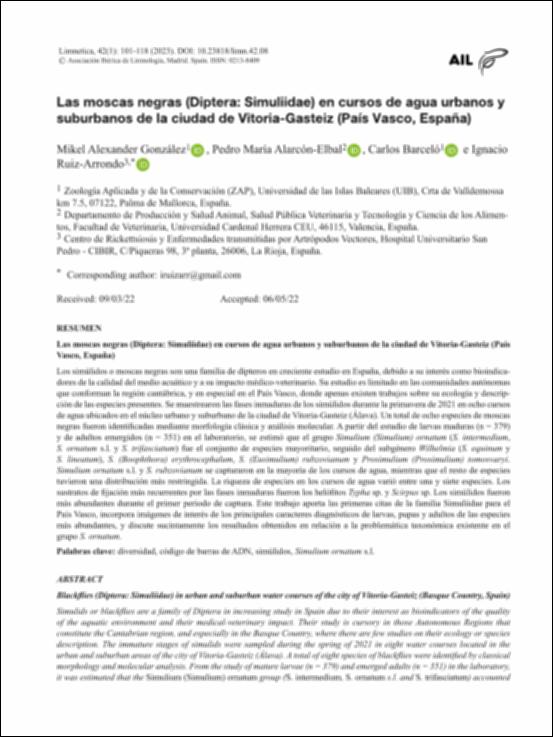Please use this identifier to cite or link to this item:
http://hdl.handle.net/10637/15474Las moscas negras (Diptera: Simuliidae) en cursos de agua urbanos y suburbanos de la ciudad de Vitoria-Gasteiz (País Vasco, España)
| Title: | Las moscas negras (Diptera: Simuliidae) en cursos de agua urbanos y suburbanos de la ciudad de Vitoria-Gasteiz (País Vasco, España) |
| Other Titles: | Blackflies (Diptera: Simuliidae) in urban and suburban water courses of the city of Vitoria-Gasteiz (Basque Country, Spain) |
| Authors : | González, Mikel Alexander Alarcón Elbal, Pedro María Barceló, Carlos Ruiz Arrondo, Ignacio |
| Keywords: | Moscas; Flies; Dípteros; Diptera; España; Spain; Biodiversidad; Biodiversity; Taxonomía animal; Animal taxonomy |
| Publisher: | Asociación Ibérica de Limnología |
| Citation: | González, M.A., Alarcón-Elbal, P.M., Barceló, C. y Ruiz-Arrondo, I. (2023). Las moscas negras (Diptera: Simuliidae) en cursos de agua urbanos y suburbanos de la ciudad de Vitoria-Gasteiz (País Vasco, España). Limnetica, vol. 42, n. 1, pp. 101-118. DOI: https://doi.org/10.23818/limn.42.08 |
| Abstract: | Los simúlidos o moscas negras son una familia de dípteros en creciente estudio en España, debido a su interés como bioindicadores de la calidad del medio acuático y a su impacto médico-veterinario. Su estudio es limitado en las comunidades autónomas que conforman la región cantábrica, y en especial en el País Vasco, donde apenas existen trabajos sobre su ecología y descripción de las especies presentes. Se muestrearon las fases inmaduras de los simúlidos durante la primavera de 2021 en ocho cursos de agua ubicados en el núcleo urbano y suburbano de la ciudad de Vitoria-Gasteiz (Álava). Un total de ocho especies de moscas negras fueron identificadas mediante morfología clásica y análisis molecular. A partir del estudio de larvas maduras (n = 379)
y de adultos emergidos (n = 351) en el laboratorio, se estimó que el grupo Simulium (Simulium) ornatum (S. intermedium, S. ornatum s.l. y S. trifasciatum) fue el conjunto de especies mayoritario, seguido del subgénero Wilhelmia (S. equinum y
S. lineatum), S. (Boophthora) erythrocephalum, S. (Eusimulium) rubzovianum y Prosimulium (Prosimulium) tomosvaryi.
Simulium ornatum s.l. y S. rubzovianum se capturaron en la mayoría de los cursos de agua, mientras que el resto de especies tuvieron una distribución más restringida. La riqueza de especies en los cursos de agua varió entre una y siete especies. Los sustratos de fijación más recurrentes por las fases inmaduras fueron los helófitos Typha sp. y Scirpus sp. Los simúlidos fueron más abundantes durante el primer periodo de captura. Este trabajo aporta las primeras citas de la familia Simuliidae para el País Vasco, incorpora imágenes de interés de los principales caracteres diagnósticos de larvas, pupas y adultos de las especies más abundantes, y discute sucintamente los resultados obtenidos en relación a la problemática taxonómica existente en el
grupo S. ornatum. Simulids or blackflies are a family of Diptera in increasing study in Spain due to their interest as bioindicators of the quality of the aquatic environment and their medical-veterinary impact. Their study is cursory in those Autonomous Regions that constitute the Cantabrian region, and especially in the Basque Country, where there are few studies on their ecology or species description. The immature stages of simulids were sampled during the spring of 2021 in eight water courses located in the urban and suburban areas of the city of Vitoria-Gasteiz (Álava). A total of eight species of blackflies were identified by classical morphology and molecular analysis. From the study of mature larvae (n = 379) and emerged adults (n = 351) in the laboratory, it was estimated that the Simulium (Simulium) ornatum group (S. intermedium, S. ornatum s.l. and S. trifasciatum) accounted for most of the collections, followed by the Wilhelmia subgenus (S. equinum and S. lineatum), S. (Boophthora) erythrocephalum, S. (Eusimulium) rubzovianum and Prosimulium (Prosimulium) tomosvaryi. Simulium ornatum s.l. and S. rubzovianum were captured in most of the water courses, while the remaining species had a more restricted distribution. The species richness in the water courses ranged from one to seven species. The most recurrent fixation substrates by the immature stages were helophytes such as Typha sp. and Scirpus sp. Simulids were more abundant during the first capture period. This study provides the first records of the family Simuliidae for the Basque Country, incorporates color images of interest of the main diagnostic characters of larvae, pupae and adults of the most abundant species recorded, and briefly discusses the results obtained in relation to the unresolved taxonomic status of the group S. ornatum. |
| URI: | http://hdl.handle.net/10637/15474 |
| Rights : | http://creativecommons.org/licenses/by-nc/4.0/deed.es Open Access |
| ISSN: | 0213-8409 |
| Issue Date: | 10-Jan-2023 |
| Center : | Universidad Cardenal Herrera-CEU |
| Appears in Collections: | Dpto. Producción y Sanidad Animal, Salud Pública Veterinaria y Ciencia y Tecnología de los Alimentos |
Items in DSpace are protected by copyright, with all rights reserved, unless otherwise indicated.


